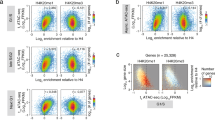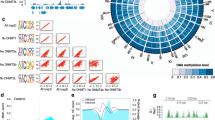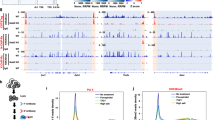Abstract
Whereas mono-, di- and trimethylation states of lysines on histones typically have specific functions, no specific functions have been attributed so far to the different methylation states of histone H3 Lysine 79 (H3K79) generated by Dot1. Here we show that Dot1, in contrast to other known histone methyltransferases, introduces multiple methyl groups via a nonprocessive mechanism. The kinetic mechanism implies that the H3K79 methylation states cannot be generated independently, suggesting functional redundancy. Indeed, gene silencing in yeast, which is dependent on Dot1, relied on global H3K79 methylation levels and not on one specific methylation state. Furthermore, our findings suggest that histone H2B ubiquitination affects H3K79 trimethylation by enhancing synthesis of all H3K79 methylation states. Our results suggest that multiple methylation of H3K79 leads to a binary code, which is expected to limit the possibilities for regulation by putative demethylases or binding proteins.
This is a preview of subscription content, access via your institution
Access options
Subscribe to this journal
Receive 12 print issues and online access
$189.00 per year
only $15.75 per issue
Buy this article
- Purchase on Springer Link
- Instant access to full article PDF
Prices may be subject to local taxes which are calculated during checkout






Similar content being viewed by others
References
Bhaumik, S.R., Smith, E. & Shilatifard, A. Covalent modifications of histones during development and disease pathogenesis. Nat. Struct. Mol. Biol. 14, 1008–1016 (2007).
Li, B., Carey, M. & Workman, J.L. The role of chromatin during transcription. Cell 128, 707–719 (2007).
Cheng, X., Collins, R.E. & Zhang, X. Structural and sequence motifs of protein (histone) methylation enzymes. Annu. Rev. Biophys. Biomol. Struct. 34, 267–294 (2005).
Klose, R.J. & Zhang, Y. Regulation of histone methylation by demethylimination and demethylation. Nat. Rev. Mol. Cell Biol. 8, 307–318 (2007).
Shi, Y. & Whetstine, J.R. Dynamic regulation of histone lysine methylation by demethylases. Mol. Cell 25, 1–14 (2007).
Taverna, S.D., Li, H., Ruthenburg, A.J., Allis, C.D. & Patel, D.J. How chromatin-binding modules interpret histone modifications: lessons from professional pocket pickers. Nat. Struct. Mol. Biol. 14, 1025–1040 (2007).
Sawada, K. et al. Structure of the conserved core of the yeast Dot1p, a nucleosomal histone H3 lysine 79 methyltransferase. J. Biol. Chem. 279, 43296–43306 (2004).
Min, J., Feng, Q., Li, Z., Zhang, Y. & Xu, R.M. Structure of the catalytic domain of human DOT1L, a non-SET domain nucleosomal histone methyltransferase. Cell 112, 711–723 (2003).
van Leeuwen, F., Gafken, P.R. & Gottschling, D.E. Dot1p modulates silencing in yeast by methylation of the nucleosome core. Cell 109, 745–756 (2002).
Okada, Y. et al. hDOT1L links histone methylation to leukemogenesis. Cell 121, 167–178 (2005).
Gazin, C., Wajapeyee, N., Gobeil, S., Virbasius, C.M. & Green, M.R. An elaborate pathway required for Ras-mediated epigenetic silencing. Nature 449, 1073–1077 (2007).
Zhang, W., Xia, X., Reisenauer, M.R., Hemenway, C.S. & Kone, B.C. Dot1a-AF9 complex mediates histone H3 Lys-79 hypermethylation and repression of ENaCα in an aldosterone-sensitive manner. J. Biol. Chem. 281, 18059–18068 (2006).
Ng, H.H. et al. Lysine methylation within the globular domain of histone H3 by Dot1 is important for telomeric silencing and Sir protein association. Genes Dev. 16, 1518–1527 (2002).
Lacoste, N., Utley, R.T., Hunter, J.M., Poirier, G.G. & Cote, J. Disruptor of telomeric silencing-1 is a chromatin-specific histone H3 methyltransferase. J. Biol. Chem. 277, 30421–30424 (2002).
San Segundo, P.A. & Roeder, G.S. Role for the silencing protein Dot1 in meiotic checkpoint control. Mol. Biol. Cell 11, 3601–3615 (2000).
Ng, H.H., Ciccone, D.N., Morshead, K.B., Oettinger, M.A. & Struhl, K. Lysine-79 of histone H3 is hypomethylated at silenced loci in yeast and mammalian cells: a potential mechanism for position-effect variegation. Proc. Natl. Acad. Sci. USA 100, 1820–1825 (2003).
Giannattasio, M., Lazzaro, F., Plevani, P. & Muzi-Falconi, M. The DNA damage checkpoint response requires histone H2B ubiquitination by Rad6-Bre1 and H3 methylation by Dot1. J. Biol. Chem. 280, 9879–9886 (2005).
Wysocki, R. et al. Role of Dot1-dependent histone H3 methylation in G1 and S phase DNA damage checkpoint functions of Rad9. Mol. Cell. Biol. 25, 8430–8443 (2005).
Shahbazian, M.D., Zhang, K. & Grunstein, M. Histone H2B ubiquitylation controls processive methylation but not monomethylation by Dot1 and Set1. Mol. Cell 19, 271–277 (2005).
Katan-Khaykovich, Y. & Struhl, K. Heterochromatin formation involves changes in histone modifications over multiple cell generations. EMBO J. 24, 2138–2149 (2005).
Liang, G., Klose, R.J., Gardner, K.E. & Zhang, Y. Yeast Jhd2p is a histone H3 Lys4 trimethyl demethylase. Nat. Struct. Mol. Biol. 14, 243–245 (2007).
Tu, S. et al. Identification of histone demethylases in Saccharomyces cerevisiae. J. Biol. Chem. 282, 14262–14271 (2007).
Botuyan, M.V. et al. Structural basis for the methylation state-specific recognition of histone H4–K20 by 53BP1 and Crb2 in DNA repair. Cell 127, 1361–1373 (2006).
Kim, J. et al. Tudor, MBT and chromo domains gauge the degree of lysine methylation. EMBO Rep. 7, 397–403 (2006).
Ng, H.H., Xu, R.M., Zhang, Y. & Struhl, K. Ubiquitination of histone H2B by Rad6 is required for efficient Dot1-mediated methylation of histone H3 lysine 79. J. Biol. Chem. 277, 34655–34657 (2002).
Briggs, S.D. et al. Gene silencing: trans-histone regulatory pathway in chromatin. Nature 418, 498 (2002).
Krogan, N.J. et al. The Paf1 complex is required for histone H3 methylation by COMPASS and Dot1p: linking transcriptional elongation to histone methylation. Mol. Cell 11, 721–729 (2003).
Zhu, B. et al. Monoubiquitination of human histone H2B: the factors involved and their roles in HOX gene regulation. Mol. Cell 20, 601–611 (2005).
Wang, H. et al. mAM facilitates conversion by ESET of dimethyl to trimethyl lysine 9 of histone H3 to cause transcriptional repression. Mol. Cell 12, 475–487 (2003).
Schneider, J. et al. Molecular regulation of histone H3 trimethylation by COMPASS and the regulation of gene expression. Mol. Cell 19, 849–856 (2005).
Dehe, P.M. et al. Protein interactions within the Set1 complex and their roles in the regulation of histone 3 lysine 4 methylation. J. Biol. Chem. 281, 35404–35412 (2006).
Dou, Y. et al. Regulation of MLL1 H3K4 methyltransferase activity by its core components. Nat. Struct. Mol. Biol. 13, 713–719 (2006).
Fingerman, I.M., Li, H.C. & Briggs, S.D. A charge-based interaction between histone H4 and Dot1 is required for H3K79 methylation and telomere silencing: identification of a new trans-histone pathway. Genes Dev. 21, 2018–2029 (2007).
Schwabish, M.A. & Struhl, K. Evidence for eviction and rapid deposition of histones upon transcriptional elongation by RNA polymerase II. Mol. Cell. Biol. 24, 10111–10117 (2004).
Altaf, M. et al. Interplay of chromatin modifiers on a short basic patch of histone H4 tail defines the boundary of telomeric heterochromatin. Mol. Cell 28, 1002–1014 (2007).
van Leeuwen, F. & Gottschling, D.E. Assays for gene silencing in yeast. Methods Enzymol. 350, 165–186 (2002).
Rusche, L.N., Kirchmaier, A.L. & Rine, J. The establishment, inheritance, and function of silenced chromatin in Saccharomyces cerevisiae. Annu. Rev. Biochem. 72, 481–516 (2003).
Ezhkova, E. & Tansey, W.P. Proteasomal ATPases link ubiquitylation of histone H2B to methylation of histone H3. Mol. Cell 13, 435–442 (2004).
Zhang, X. et al. Structural basis for the product specificity of histone lysine methyltransferases. Mol. Cell 12, 177–185 (2003).
Tamaru, H. et al. Trimethylated lysine 9 of histone H3 is a mark for DNA methylation in Neurospora crassa. Nat. Genet. 34, 75–79 (2003).
Patnaik, D. et al. Substrate specificity and kinetic mechanism of mammalian G9a histone H3 methyltransferase. J. Biol. Chem. 279, 53248–53258 (2004).
Collins, R.E. et al. In vitro and in vivo analyses of a Phe/Tyr switch controlling product specificity of histone lysine methyltransferases. J. Biol. Chem. 280, 5563–5570 (2005).
Dirk, L.M. et al. Kinetic manifestation of processivity during multiple methylations catalyzed by SET domain protein methyltransferases. Biochemistry 46, 3905–3915 (2007).
Eskeland, R. et al. The N-terminus of Drosophila SU(VAR)3–9 mediates dimerization and regulates its methyltransferase activity. Biochemistry 43, 3740–3749 (2004).
Chin, H.G., Patnaik, D., Esteve, P.O., Jacobsen, S.E. & Pradhan, S. Catalytic properties and kinetic mechanism of human recombinant Lys-9 histone H3 methyltransferase SUV39H1: participation of the chromodomain in enzymatic catalysis. Biochemistry 45, 3272–3284 (2006).
McBride, A.E. & Silver, P.A. State of the Arg: protein methylation at arginine comes of age. Cell 106, 5–8 (2001).
Barski, A. et al. High-resolution profiling of histone methylations in the human genome. Cell 129, 823–837 (2007).
Janzen, C.J., Hake, S.B., Lowell, J.E. & Cross, G.A. Selective di- or trimethylation of histone H3 lysine 76 by two DOT1 homologs is important for cell cycle regulation in Trypanosoma brucei. Mol. Cell 23, 497–507 (2006).
Lee, J.S. et al. Histone crosstalk between H2B monoubiquitination and H3 methylation mediated by COMPASS. Cell 131, 1084–1096 (2007).
Rappsilber, J., Ishihama, Y. & Mann, M. Stop and go extraction tips for matrix-assisted laser desorption/ionization, nanoelectrospray, and LC/MS sample pretreatment in proteomics. Anal. Chem. 75, 663–670 (2003).
Krijgsveld, J., Gauci, S., Dormeyer, W. & Heck, A.J. In-gel isoelectric focusing of peptides as a tool for improved protein identification. J. Proteome Res. 5, 1721–1730 (2006).
Acknowledgements
We thank D. Gottschling (Fred Hutchinson Cancer Research Center) and R. Gardner (University of Washington) for plasmids and reagents, H. Hilkmann for peptide synthesis, K. Verzijlbergen (The Netherlands Cancer Institute (NKI)) for the antibody against the C terminus of histone H3 and E. Battaglia for help with initial experiments. We thank X. Cheng, D. Gottschling, P. Borst, T. Sixma, B. van Steensel and members of the van Leeuwen laboratory for critical reading of the manuscript and helpful discussions. F.v.L. was a Special Fellow of the Leukemia and Lymphoma Society and was supported by NOE The Epigenome of the EU 6th framework program. This work was supported by the Netherlands Proteomics Centre.
Author information
Authors and Affiliations
Contributions
F.F. was responsible for strain constructions, sample preparations, western blots, nonradioactive in vitro assays, silencing assays, DNA-damage checkpoint assays and antibody generation and characterization; M.T. and G.O. developed and performed MS analyses under supervision of J.K.; T.v.W. performed the initial characterization of the Dot1-G401A mutant; M.F. developed the binomial distributive methylation model; F.v.L. devised and supervised the project; F.F. and F.v.L. wrote the paper.
Corresponding author
Supplementary information
Supplementary Text and Figures
Supplementary Figues 1–5 and Supplementary Table 1 (PDF 1094 kb)
Rights and permissions
About this article
Cite this article
Frederiks, F., Tzouros, M., Oudgenoeg, G. et al. Nonprocessive methylation by Dot1 leads to functional redundancy of histone H3K79 methylation states. Nat Struct Mol Biol 15, 550–557 (2008). https://doi.org/10.1038/nsmb.1432
Received:
Accepted:
Published:
Issue Date:
DOI: https://doi.org/10.1038/nsmb.1432
This article is cited by
-
Methylation across the central dogma in health and diseases: new therapeutic strategies
Signal Transduction and Targeted Therapy (2023)
-
Dynamic epistasis analysis reveals how chromatin remodeling regulates transcriptional bursting
Nature Structural & Molecular Biology (2023)
-
The dual methyltransferase METTL13 targets N terminus and Lys55 of eEF1A and modulates codon-specific translation rates
Nature Communications (2018)
-
Dot1 regulates nucleosome dynamics by its inherent histone chaperone activity in yeast
Nature Communications (2018)
-
Tri-methylation of H3K79 is decreased in TGF-β1-induced epithelial-to-mesenchymal transition in lung cancer
Clinical Epigenetics (2017)



